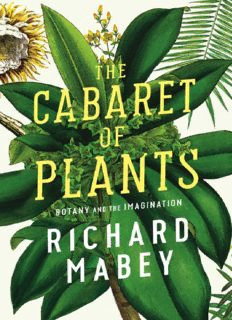
The Cabaret of Plants: Botany and the Imagination PDF
Preview The Cabaret of Plants: Botany and the Imagination
THE CABARET OF PLANTS RICHARD MABEY is one of our greatest nature writers. He is the author of some thirty books, including the bestselling plant bible Flora Britannica, Food for Free, Turned Out Nice Again, Weeds: the Story of Outlaw Plants and Nature Cure which was shortlisted for the Whitbread, Ondaatje and Ackerley Awards. His biography, Gilbert White, won the Whitbread Biography Award. A regular commentator on radio and in the national press, he was elected a Fellow in the Royal Society of Literature in 2012. He lives in Norfolk. Also by Richard Mabey The Perfumier and the Stinkhorn Turned Out Nice Again Weeds Food for Free The Unofficial Countryside The Common Ground The Flowering of Britain Gilbert White Home Country Whistling in the Dark: In Pursuit of the Nightingale Flora Britannica Selected Writing 1974–1999 Nature Cure Fencing Paradise Beechcombings A Brush with Nature Dreams of the Good Life: The Life of Flora Thompson and the Creation of Lark Rise to Candleford THE CABARET OF PLANTS BOTANY AND THE IMAGINATION RICHARD MABEY for Vivien The force that through the green fuse drives the flower Drives my green age … Dylan Thomas Contents Introduction: The Vegetable Plot HOW TO SEE A PLANT 1. Symbols from the Ice: Plants as Food and Forms 2. Bird’s-Eyes: Primulas WOODEN MANIKINS: THE CULTS OF TREES 3. The Cult of Celebrity: The Fortingall Yew 4. The Rorschach Tree: Baobab 5. The Big Trees: Sequoias 6. Methuselahs: Bristlecones and Date Palms 7. Provenance and Extinction: Wood’s Cycad 8. From Workhorse to Green Man: The Oak MYTHS OF CULTIVATION 9. The Celtic Bush: Hazel 10. The Vegetable Lamb: Cotton 11. Staff of Life: Maize 12. The Panacea: Ginseng 13. The Vegetable Mudfish: Samphire THE SHOCK OF THE REAL: SCIENTISTS AND ROMANTICS 14. Life versus Entropy: Newton’s Apple 15. Intimations of Photosynthesis: Mint and Cucumber 16. The Challenge of Carnivorous Plants: The Tipitiwitchet 17. Wordsworth’s Daffodils 18. On Being Pollinated: Keats’s Forget-Me-Not NEW LANDS, NEW VISIONS 19. Jewels of the Desert: Francis Masson’s Starfish and Birds of Paradise 20. Growing Together: The East India Company’s Fusion Art 21. Chiaroscuro: The Impressionists’ Olive Trees 22. Local Distinctiveness: Cornfield Tulips and Horizontal Flax THE VICTORIAN PLANT THEATRE 23. ‘Vegetable jewellery’: The Fern Craze 24. ‘The Queen of Lilies’: Victoria amazonica 25. A Sarawakan Stinkbomb: The Titan Arum 26. Harlequins and Mimics: The Orchid Troupe THE REAL LANGUAGE OF PLANTS 27. The Butterfly Effect: The Moonflower 28. The Canopy Cooperative: Air Plants and Bromeliads 29. Plant Intelligence: Mimosa Epilogue: The Tree of After Life Additional References and Sources List of Illustrations Acknowledgements Index Introduction: The Vegetable Plot JUST BEFORE HE DIED in 1888 Edward Lear sketched the last of the surreal additions to evolution’s menagerie that he’d begun with the Bong-tree in ‘The Owl and the Pussycat’ nearly twenty years before. His Nonsense Botany is a series of impish cartoons of preposterous floral inventions. It includes a strawberry bush bearing puddings instead of fruit, the parrot-flowered Cockatooca superba and the unforgettable Manypeeplia upsidownia, a kind of Solomon’s seal with minute humans suspended like flowers along the bowed stalk. Lear was a lifelong sufferer from epilepsy and depressive episodes (which he nicknamed ‘the Morbids’ as if they were a tribe of gloomy rodents) and the obsessive fun he had with words and forms may have been a way of exorcising his melancholy. But I suspect there is more to his final creation. Lear was an astute botanist as well as a brilliant humorist. He’d travelled and painted across the Old World, especially in the Mediterranean, and had seen first hand many of its bizarre plants, including the carrion-stinking dragon arum (which he described as ‘brutal-filthy yet picturesque’), and I think his nonsense flora can be seen as a kind of celebratory cabaret, an affectionate satire on the astonishing revelations of nineteenth-century botany.
Description: